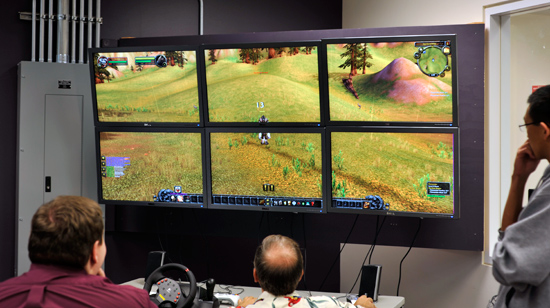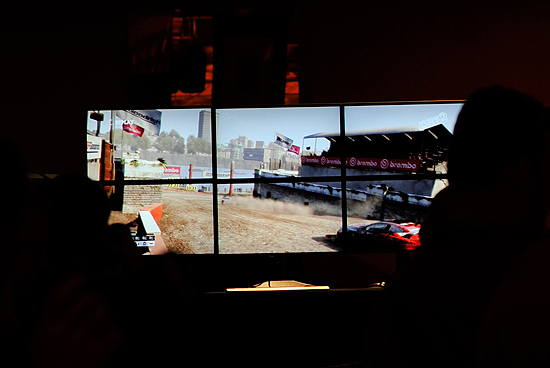Beginnings of the Holodeck: AMD's DX11 GPU, Eyefinity and 6 Display Outputs
by Anand Lal Shimpi on September 10, 2009 2:30 PM EST- Posted in
- GPUs
The First Generation Holodeck by 2016
When AMD first told me about the RV770 they told me another interesting story. For the past several years AMD (and ATI before it) has been obsessed with trying to figure out when it would be possible to render an image so convincing that it was indistinguishable (at least mostly) from reality.
Given the right art and a good technique to render the scene, this is totally possible not only within our lifetimes but within the next decade. Unfortunately, that's not enough.
Carrell estimates that the human eye can directly resolve around 7 million pixels, almost twice the resolution of a 30" display. But that's just what it's directly focusing on, all of the peripherial vision brings the total up to around 100 million pixels. The Eyefinity demo I showed earlier was running at 24.5 million pixels on a single GPU; you can estimate that at this generation we'll be able to do about 50 million pixels with two GPUs and one more generation from now we'll get to that 100 million pixel marker. That's two years for a single GPU. Then give it a few more years to be able to render that many pixels but with enough complexity to actually look real.
Rendering something at the max resolution that the human eye can resolve isn't enough however; you have to feel immersed in the graphics. That's where Eyefinity comes in, at least what it starts to come in.
Carrell believes that in seven years we can have the first generation Holodeck up and running. For those of you who aren't familiar with the Trek reference, Carrell believes it'll take seven years to be able to deliver a 180 degree hemispherical display (you're not completely surrounded by displays but at least your forward and peripheral vision is) with positionally accurate and phase accurate sound (both calculated by the GPU in real time). The GPU will also be used to recognize speech, track gestures and track eye movement/position.
It doesn't solve the issue of not being able to walk forward indefinitely, but again this is only the first generation Holodeck.
Eyefinity isn't anywhere close, but if you understand the direction: it's a start.

We're at six 2560 x 1600 displays today, is it too far fetched to imagine a totally immersive display setup that renders at life-like resolutions?
First person shooters pretty much dictate that you'll need an odd number of displays to avoid your crosshairs spanning multiple monitors. With three displays you can begin to get the immersion effect, but buy five and you'll be completely surrounded by your game. And as I mentioned before, it doesn't require any special application or OS support, the drivers take care of everything: it just appears as a single, large, surface.
It seems trivial but honestly we haven't had the ability to easily support the ridiculous display setups we always see in sci-fi movies. Eyefinity at least makes it look like we can build the PCs from the Matrix.
Will it succeed? Who knows. Does it sound gimmicky? Sure. Is it cool? Yeah, I'd say so.

If panel prices could drop significantly enough where putting together an Eyefinity display setup didn't cost more than the graphics card, I think it'd be a much easier sell. Obviously AMD's next-generation GPU is more than just Eyefinity, but you'll hear about the rest late this month.










137 Comments
View All Comments
SnowleopardPC - Sunday, September 13, 2009 - link
"um projectors?buy 6 cheap led projectors, 800x480 resolution each, easily make a surround setup with it too.
best part is no bezels. thats the ticket. "
What in the world is that about. I think everyone here is looking at a minimum resolution of 1920x1080 or 1920x1200 for a 24 inch panel. To get that in a projector would cost about $2400 right now per projector.
For me to do that with this step, I would need 6 of them.
Now if you are talking about 30 inch panels, then the resolution per panel is 2560x1600.
Try finding a projector that normal people can afford with the pixel count, and then multiply it by 6
Once Dell comes out with an OLED 30 inch panel with out a bezel I am in for 6 of them.
HD TV is already obsolete and it has been for a long time.
Shadowmaster625 - Friday, September 11, 2009 - link
I dont really see the appeal of a wraparound display in the concave styles. No matter what you do it isnt going to be 3D and its not going to fool anyone.However, imagine if you took 2 monitors and angled them in the opposite manner, so that they were at a slight angle away from you. Convex in other words. Then you can generate a convincing 3D image. In theory, if you had a semi-spherical display, it could generate a very convincing 3D image. It would take some powerful software, but it would look cool as hell.
diggernash - Friday, September 11, 2009 - link
Don't know if it is mentioned above, but you can throw 3 (well 6 now) LCD projectors onto angled screens and do away with the bezel lines all together. And no, it does not work the same as projecting one big screen. The screens on the side definitely add to the experience.diggernash - Friday, September 11, 2009 - link
take that LCD outta my comments, massive brain failurekekewons - Friday, September 11, 2009 - link
Right. Probably better using DLP projectors (particularly since the latter are more flexible with regard to 3D technologies.xetura - Friday, September 11, 2009 - link
If you've never used a multi-monitor setup, you know that the monitor edges don't mean jack squat. For a triple setup, you don't actually look at the outer monitors. They're for peripheral vision. Alot of people miss the point entirely on that. Now for a x6 setup, yes this would be annoying, but for 3x or 5x setups, you don't even notice it. After racing on a x3 setup, racing on anything else is completely pointless. It's something that truly needs to be experienced to understand.kekewons - Friday, September 11, 2009 - link
I agree, if for no other reason that a 6x2 setup would have two of the six monitor top/bottem edges close to the center of the large image. I'm quite sure it would be unworkable for me, in the long run.Doesn't mean the vertical monitor edges in a 3 monitor rig are as intrusive, however, and I tend to believe they wouldn't be, yes.
They won't be, if your brain can get past them, any more that the low resolution/hi-pixelization image of a large, close projection would be.
But the big question is "IF." Yes, I can look past the low res image out onto the imaginary road beyond...but others might find it more difficult.
And maybe you can easily ignore vertical edge on a flatscreen, while I find it more difficult to do so....
Projection solutions should make both of those issues easier to solve.
Agree too that the tow peripheral monitors (or projections) in a three monitor/projector setup should NOT require either hi-resolution or even focus--ideally they are seen out of the corners of the two eyes, and are important only for determining overall sense of speed when driving--for viewing "objects passing by at high speeds."
willssi - Friday, September 11, 2009 - link
The person who took the pictures for the article should have been standing further back. For displays this large, they actually don't look good if you're too close to them. Something like the 2 x 3 setup would require you be a good 10 - 15 feet away from it to make the bezels less noticeable and really show off the massive resolution.Home theater guys will tell you when you're buying a big screen TV that you need XX feet from the TV, minimum, for it to look good. Same goes for this setup. The best picture was the last one on the 2nd page, of Dirt 2 I believe. A little distance back really shows off how crisp and huge this display setup is. Seeing several balding white guys sitting 2 feet from this massive display doesn't really give you a sense of how it will look in person.
kekewons - Friday, September 11, 2009 - link
I can appreciate the desire NOT to see individual pixels in any given image, and, yes, I certainly share that ultimate goal......but at the same time, I think there IS something to be said for seeing a very large image up close--at a certain point, the "immersion" factor kicks in, and it really can help offset the downside of seeing a large image under low-resolution.
I drive racing simulations using a XGA resolution projector, and I have it set up to throw a LARGE image not far from my eyes--60" horizontal image (4:3) only 36" or so from my eyes.
It certainly IS pixelated, yes. The Windows hourglass is just silly.
But when used to experience a "3D space" I find myself looking through the screen...and therefore past the pixels...into that 3D world.
I will agree in the next breath that seeing 2D chat can be a problem, however. :D
So I often turn it off....
Noctifer - Friday, September 11, 2009 - link
Ye, it looks better from the distance rather than from close. But most people won't use Eyefinity, the really great part of the card is its power. I mean being able to run Dirt 2 on a playable frame rate on such a high resolution is quite impressive.Can't wait till some PC magazines get their hands on one of those and show us the real difference in power compared with current cards.